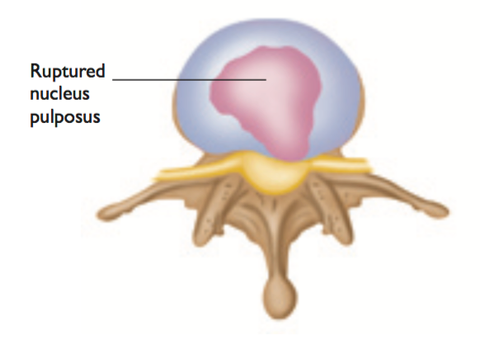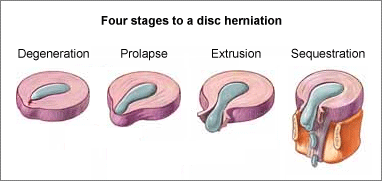Common Back Pain - Disc Prolapse (Slipped/Ruptured/Herniated Disc)
A slipped disc (also known as a herniated, ruptured or prolapsed disc) results when the shock-absorbing pads or intervertebral discs split or rupture
Discs are segments of connective tissue that separate the vertebrae of the spine, providing absorption from shock and allowing for the smooth flexing of the neck and back without the vertebral bones rubbing against each other.
The discs contain a jelly-like substance which seeps out into the surrounding tissue, causing local inflammation and pressure on the spinal nerves (and occasionally the spinal cord) where they exit the spinal canal.
Slipped discs most frequently occur in the lower back although any disc of the spine is vulnerable to rupture.

Cause of Injury
Improper weightlifting technique. Excessive strain. Forceful trauma to the vertebral disc.
Signs and symptoms
Pain in the back or neck. Numbness, tingling or pain in the buttocks, back, upper or lower limb. Changes in bowel or bladder function (this is rare but should be treated as a medical emergency).
Complications if Left Unattended
Slipped or herniated discs require medical attention and evaluation. Symptoms of slipped disc may indicate other underlying ailments including fracture, tumors, infection or nerve damage, with serious – in certain cases, life-threatening – implications.

Immediate Treatment
Bed rest, application of alternating ice and heat. Use of anti-inflammatory and analgesic medication.
Rehabilitation and Prevention
Rest and limited activity for several days is usually indicated, though normal, non- athletic daily activity should be resumed soon thereafter to prevent atrophy and restore mobility in the spine.
Physical therapy may be combined with massage and gradually increasing exercise of the back after the pain has subsided.
Strengthening and flexibility exercises, proper warm-up, avoidance of excessive or sudden weight lifting and attention to good sports technique may help avoid the injury.
Trigger Points
Trigger points are often associated with back pain and active trigger points (glutes, piriformis, and abdominal muscles) should be addressed to prevent reoccurrence of the condition.
Long-Term Prognosis
Most disc injuries are resolved without surgery, given proper recovery time.
Though full restoration of strength and mobility may generally be expected, discs are vulnerable to re-injury, particularly for weightlifters and athletes placing significant demands on the back muscles, tendons and ligaments and on the spine itself.
Conservative Treatments
Conservative treatments for a prolapsed disc, also known as a herniated or slipped disc, aim to alleviate symptoms, reduce inflammation, and promote healing without the need for surgical intervention. These treatments focus on managing pain, improving mobility, and preventing further damage to the affected disc. Here's a closer look at some common conservative treatments for a prolapsed disc:
-
Pain Management: Managing pain is often the first priority in treating a prolapsed disc. Nonsteroidal anti-inflammatory drugs (NSAIDs), such as ibuprofen or naproxen, can help reduce inflammation and alleviate pain. In some cases, muscle relaxants may also be prescribed to ease muscle spasms associated with disc herniation.
-
Physical Therapy: Physical therapy plays a crucial role in the conservative management of a prolapsed disc. A physical therapist can design a customized exercise program to strengthen the muscles supporting the spine, improve flexibility, and correct posture. Additionally, manual therapy techniques, such as spinal manipulation, traction, mobilization, and massage therapy, may be used to relieve pressure on the affected disc and surrounding tissues.
-
Massage Therapy: Therapeutic massage techniques, such as deep tissue massage, myofascial release, and trigger point therapy, can help alleviate muscle tension, improve circulation, and reduce pain associated with disc herniation. Massage therapists can target specific areas of tightness or discomfort around the affected disc, promoting relaxation and facilitating healing.
-
Heat and Cold Therapy: Applying heat or cold to the affected area can help alleviate pain and reduce inflammation associated with a prolapsed disc. Heat therapy, such as heating pads or warm baths, can help relax muscles and increase blood flow to the affected area. Cold therapy, such as ice packs or cold compresses, can help numb the area and reduce swelling.
-
Activity Modification: In some cases, modifying daily activities and avoiding movements or positions that exacerbate symptoms can help alleviate pain and prevent further injury to the prolapsed disc. This may involve avoiding heavy lifting, bending at the waist, or sitting for prolonged periods. Using ergonomic equipment, such as supportive chairs or lumbar cushions, can also help maintain proper spinal alignment.
-
Steroid Injections: If conservative treatments alone are not providing sufficient relief, corticosteroid injections may be recommended. These injections deliver powerful anti-inflammatory medication directly to the affected area, providing targeted pain relief and reducing inflammation around the prolapsed disc.
-
Bracing: In certain cases, wearing a supportive brace or corset may be beneficial in stabilizing the spine and reducing pressure on the affected disc. A brace can help limit movement in the spine and provide additional support during activities that may aggravate symptoms.
-
Education and Lifestyle Modification: Educating patients about proper body mechanics, posture, and ergonomics can help prevent further injury and promote long-term spinal health. Encouraging lifestyle modifications, such as maintaining a healthy weight, quitting smoking, and engaging in regular exercise, can also support recovery and reduce the risk of future disc herniation.
It's important to note that the effectiveness of conservative treatments for a prolapsed disc can vary depending on the severity of symptoms and individual factors. Patients should work closely with their healthcare provider to develop a comprehensive treatment plan tailored to their specific needs and goals. In some cases, surgery may be recommended if conservative treatments fail to provide relief or if there is significant nerve compression requiring immediate intervention
This blog is intended to be used for information purposes only and is not intended to be used for medical diagnosis or treatment or to substitute for a medical diagnosis and/or treatment rendered or prescribed by a physician or competent healthcare professional. This information is designed as educational material, but should not be taken as a recommendation for treatment of any particular person or patient. Always consult your physician if you think you need treatment or if you feel unwell.
About Niel Asher Education
Niel Asher Education (NAT Global Campus) is a globally recognised provider of high-quality professional learning for hands-on health and movement practitioners. Through an extensive catalogue of expert-led online courses, NAT delivers continuing education for massage therapists, supporting both newly qualified and highly experienced professionals with practical, clinically relevant training designed for real-world practice.
Beyond massage therapy, Niel Asher Education offers comprehensive continuing education for physical therapists, continuing education for athletic trainers, continuing education for chiropractors, and continuing education for rehabilitation professionals working across a wide range of clinical, sports, and wellness environments. Courses span manual therapy, movement, rehabilitation, pain management, integrative therapies, and practitioner self-care, with content presented by respected educators and clinicians from around the world.
Known for its high production values and practitioner-focused approach, Niel Asher Education emphasises clarity, practical application, and professional integrity. Its online learning model allows practitioners to study at their own pace while earning recognised certificates and maintaining ongoing professional development requirements, making continuing education accessible regardless of location or schedule.
Through partnerships with leading educational platforms and organisations worldwide, Niel Asher Education continues to expand access to trusted, high-quality continuing education for massage therapists, continuing education for physical therapists, continuing education for athletic trainers, continuing education for chiropractors, and continuing education for rehabilitation professionals, supporting lifelong learning and professional excellence across the global therapy community.

Continuing Professional Education
Looking for Massage Therapy CEUs, PT and ATC continuing education, chiropractic CE, or advanced manual therapy training? Explore our evidence-based online courses designed for hands-on professionals.


















